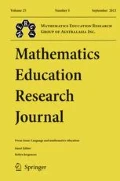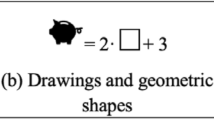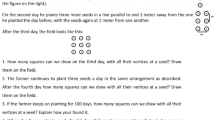Abstract
We describe 24 third (8–9 years old) and 24 fifth (10–11 years old) graders’ generalization working with the same problem involving a function. Generalizing and representing functional relationships are considered key elements in a functional approach to early algebra. Focusing on functional relationships can provide insights into how students work with two or more covarying quantities rather than isolated computations, and focusing on representations can help to identify the type of representations useful to them. The goals of this study are to (1) describe the functional relationships evidenced in students’ responses and (2) describe the representations that the students use. In addressing these research objectives, we describe student responses drawn from a Classroom Teaching Experiment in each grade. We analyzed students’ written responses to different questions designed to generalize the relationships in a problem that involves the function y = 2x + 6. Our findings illustrate that 11 third graders and 19 fifth graders provide evidence of functional relationships in their responses. Three third graders and all fifth graders generalized the relationship. We conclude that these differences may be due to the students’ previous classroom mathematical experiences, since students in higher grades would be more likely to focus on the relationships between variables, whereas third graders would focus on the details of arithmetic computations. In addition, we find that natural language is the main vehicle used to generalize in both grades. Unlike third graders, fifth graders perceive general rules from the numerical calculation and express these generalizations even when not explicitly requested to do so.












Similar content being viewed by others
Notes
This study focuses on external representations to distinguish them from mental or internal ones. We therefore use the term “representation” or “representations” to refer to external representations, produced with pencil and paper, that are intentional, permanent, and spatial in nature.
To respect students’ anonymity, each was assigned a code consisting of the letter “T” to third graders and “F” to fifth graders, and a number from 1 to 24.
References
Amit, M., & Neria, D. (2008). “Rising to the challenge”: using generalization in pattern problems to unearth the algebraic skills of talented pre-algebra students. ZDM, 40, 111–129.
Blanton, M. (2008). Algebra and the elementary classroom: transforming thinking, transforming practice. Portsmouth, NH: Heinemann.
Blanton, M. L. (2017). Algebraic reasoning in grades 3-5. In M. T. Battista (Ed.), Reasoning and sense making in the mathematics classroom. Grades 3–5 (pp. 67–102). NCTM: Reston, VA.
Blanton, M. L., & Kaput, J. J. (2005). Helping elementary teachers build mathematical generality into curriculum and instruction. ZDM, 37(1), 34–42.
Blanton, M. L., & Kaput, J. J. (2011). Functional thinking as a route into algebra in the elementary grades. In J. Cai & E. Knuth (Eds.), Early algebraization. Advances in mathematics education (pp. 5–23). Berlin: Springer.
Blanton, M. L., Levi, L., Crites, T., & Dougherty, B. (Eds.). (2011). Developing essential understanding of algebraic thinking for teaching mathematics in grades 3–5. Reston, VA: NCTM.
Blanton, M. L., Brizuela, B. M., Gardiner, A., Sawrey, K., & Newman-Owens, A. (2015). A learning trajectory in 6-year-olds’ thinking about generalizing functional relationships. Journal for Research in Mathematics Education, 46(5), 511–558.
Blanton, M. L., Isler-Baykal, I., Stroud, R., Stephens, A., Knuth, E., et al. (2019). (first online). Growth in children’s understanding of generalizing and representing mathematical structure and relationships. Educational Studies in Mathematics.
Brizuela, B., & Earnest, D. (2008). Multiple notational systems and algebraic understanding: the case of the “best deal” problem. In J. J. Kaput, D. W. Carraher, & M. L. Blanton (Eds.), Algebra in the early grades (pp. 273–302). New York, NY: LEA.
Cañadas, M. C., & Castro, E. (2007). A proposal of categorisation for analysing inductive reasoning. PNA, 1(2), 67-78.
Cañadas, M. C., & Molina, M. (2016). Una aproximación al marco conceptual y principales antecedentes del pensamiento funcional en las primeras edades [Approach to the conceptual framework and background of functional thinking in the early years]. In E. Castro, E. Castro, J. L. Lupiáñez, J. F. Ruíz-Hidalgo, & M. Torralbo (Eds.), Investigación en educación matemática. Homenaje a Luis Rico (pp. 209-218). Granada, Spain: Comares.
Cañadas, M. C., Brizuela, B. M., & Blanton, M. (2016). Second graders articulating ideas about linear functional relationships. The Journal of Mathematical Behavior, 41, 87–103
Carpenter, T., & Levi, L. (2000). Developing conceptions of algebraic reasoning in the primary grades (Research report No. 00-2). Madison, WI: National Center for Improving student Learning and Achievement in Mathematics and Science.
Carraher, D. W., & Schliemann, A. D. (2002). The transfer dilemma. The Journal of the Learning Sciences, 11(1), 1–24.
Carraher, D. W., & Schliemann, A. D. (2007). Early algebra and algebraic reasoning. In F. K. Lester (Ed.), Second handbook of research on mathematics teaching and learning (Vol. 2, pp. 669–705). Reston, VA: NCTM.
Carraher, D. W., & Schliemann, A. D. (2015). Powerful ideas in elementary school mathematics. In L. D. English & D. Kirshner (Eds.), Handbook of international research in mathematics education (pp. 191–208). New York, NY: Routledge.
Carraher, D. W., & Schliemann, A. D. (2019). Early algebraic thinking and the US mathematics standards for grades K to 5. Journal for the Study of Education and Development, 43(2), 479–522.
Carraher, D. W., Martinez, M., & Schliemann, A. (2008a). Early algebra and mathematical generalization. ZDM, 40(1), 3–22.
Carraher, D. W., Schliemann, A. D., & Schwartz, J. L. (2008b). Early algebra is not the same as algebra early. In J. J. Kaput, D. W. Carraher, & M. L. Blanton (Eds.), Algebra in the early grades (pp. 235–272). New York, NY: LEA.
Chazan, D. (2000). Beyond formulas in mathematics and teaching: dynamics of the high school algebra classroom. New York, NY: Teachers College Press.
Cobb, P., & Gravemeijer, K. (2008). Experimenting to support and understand learning processes. In A. E. Kelly, R. A. Lesh, & J. Y. Baek (Eds.), Handbook of design research methods in education. Innovation in science, technology, engineering and mathematics learning and teaching (pp. 68–95). Mahwah, NJ: Lawrence Erlbaum Associates.
Confrey, J., & Smith, E. (1994). Exponential functions, rates of change, and the multiplicative unit. Educational Studies in Mathematics, 26(2–3), 135–164.
Cooper, T. J., & Warren, E. (2008). The effect of different representations on years 3 to 5 students’ ability to generalise. ZDM, 40(1), 23–37.
Cooper, T. J., & Warren, E. (2011). Years 2 to 6 students’ ability to generalise: models, representations and theory for teaching and learning. In J. Cai (Ed.), Early algebraization. Advances in mathematics education (pp. 187–214). Berlin, Germany: Springer.
Dienes, Z. P. (1961). On abstraction and generalization. Harvard Educational Review, 31(3), 281–301.
Dubinsky, E., & Harel, G. (1992). The concept of function: aspects of epistemology and pedagogy. Washington, DC: Mathematical Association of America.
English, L. D., & Warren, E. A. (1998). Introducing the variable through pattern exploration. The Mathematics Teacher, 19(2), 166–170.
Freudenthal, H. (1992). Variables and functions. In G. V. Barneveld & H. Krabbendam (Eds.), Proceedings of conference on functions (pp. 7–20). Enschede: National Institute for Curriculum Development.
Kaput, J. J. (2008). What is algebra? What is algebraic reasoning? In J. J. Kaput, D. W. Carraher, & M. L. Blanton (Eds.), Algebra in the early grades (pp. 5–17). New York, NY: Lawrence Erlbaum Associates.
Kelly, A. E., & Lesh, R. A. (2000). Research design in mathematics and science education. New Jersey: Lawrence Erlbaum Associates.
Kieran, C. (1989). The early learning of algebra: a structural perspective. In S. Wagner & C. Kieran (Eds.), Research issues in the learning and teaching of algebra (pp. 33–56). Reston, VA: NCTM.
Küchemann, D. (1981). Algebra. In K. Hart (Ed.), Children’s understanding of mathematics: 11–16 (pp. 102–119). London: John Murray.
MacGregor, M., & Stacey, K. (1995). The effect of different approaches to algebra on students’ perceptions of functional relationships. Mathematics Education Research Journal, 7(1), 69–85.
Mason, J. (1996). Expressing generality and roots of algebra. In B. Bednarz, C. Kieran, & L. Lee (Eds.), Approaches to algebra (pp. 65–86). Dordrecht: Kluwer Academic Publishers.
Ministerio de Educación, Cultura y Deporte (2014). Real Decreto 126/2014, de 28 de febrero, por el que se establece el currículo básico de la educación primaria [Royal Decree 126/2014, of 28 February, by which the corresponding core curriculum for primary education is established]. Boletín Oficial del Estado, 52, 19349–19420.
Moss, J., & McNab, S. L. (2011). An approach to geometric and numeric patterning that fosters second grade students’ reasoning and generalizing about functions and co-variation. In J. Cai & E. Knuth (Eds.), Early algebraization. A global dialogue from multiple perspectives (pp. 277–301). Berlin: Springer.
Moss, J., Beatty, R., Barkin, S., & Shillolo, G. (2008). What is your theory? What is your rule? Fourth graders build an understanding of functions through patterns and generalizing problems. In C. E. Greenes & R. Rubenstein (Eds.), Algebra and algebraic thinking in school mathematics (pp. 155–168). Reston, VA: NCTM.
Merino, E., Cañadas, M. C., & Molina, M. (2013). Uso de representaciones y patrones por alumnos de quinto de educación primaria en una tarea de generalización [Representations and patterns used by fifth grade students in a generalization task]. Edma 0-6: Eduación Matemática en la Infancia, 2(1), 24-40.
Morales, R., Cañadas, M. C., Brizuela, B. M., & Gómez, P. (2018). Relaciones funcionales y estrategias de alumnos de primero de Educación Primaria en un contexto funcional [Functional relationships and strategies of first graders in a functional context]. Enseñanza de las Ciencias, 36(3), 59-78.
Pinto, E., & Cañadas, M. C. (2018). Generalization in fifth graders within a functional approach. PNA, 12(3), 173-184.
Pinto, E., Brizuela, B. M., & Cañadas, M. C. (2019, February). Representational variation among elementary school students: A study within a functional approach to early algebra. In U. T. Jankvist, M. van den Heuvel-Panhuizen, & M. Veldhuis (Eds.), The Eleventh Congress of the European Society for Research in Mathematics Education. Utrecht, The Netherlands: Freudenthal Group and Freudenthal Institute, Utrecht University & ERME
Radford, L. (2003). Gestures, speech, and the sprouting of signs: a semiotic–cultural approach to students’ types of generalization. Mathematical Thinking and Learning, 5(1), 37–70.
Radford, L. (2018). The emergence of symbolic algebraic thinking in primary school. In C. Kieran (Ed.), Teaching and learning algebraic thinking with 5- to 12-year-olds, ICME-13 Monographs (pp. 3-25). Cham: Springer.
Rivera, F. D., & Becker, J. R. (2011). Formation of pattern generalization involving linear figural patterns among middle school students: results of a three-year study. In J. Cai & E. Knuth (Eds.), Early algebraization: a global dialogue from multiple perspectives (pp. 277–301). Berlin: Springer.
Schifter, D., Bastable, V., Russell, S. J., Seyferth, L., & Riddle, M. (2008). Algebra in the grades K–5 classroom: learning opportunities for students and teachers. In C. E. Greenes & R. Rubenstein (Eds.), Algebra and algebraic thinking in school mathematics: seventieth yearbook of the National Council of Teachers of Mathematics (pp. 263–277). Reston, VA: NCTM.
Schwartz, J. L., & Yerushalmy, M. (1992). Getting students to function on and with algebra. In E. Dubinsky & G. Harel (Eds.), The concept of function: aspects of epistemology and pedagogy (pp. 261–289). Washington, DC: Mathematical Association of America.
Sfard, A. (1991). On the dual nature of mathematical conceptions: reflections on processes and objects as different sides of the same coin. Educational Studies in Mathematics, 22(1), 1–36.
Smith, E. (2008). Representational thinking as a framework for introducing functions in the elementary curriculum. In J. J. Kaput, D. W. Carraher, & M. L. Blanton (Eds.), Algebra in the early grades (pp. 133–163). New York, NY: Lawrence Erlbaum Associates.
Stephens, A. C., Ellis, A. B., Blanton, M. L., & Brizuela, B. M. (2017). Algebraic thinking in the elementary and middle grades. In J. Cai (Ed.), Compendium for research in mathematics education (pp. 386–420). Reston, VA: NCTM.
Tinsley, H. E., & Weiss, D. J. (2000). Interrater reliability and agreement. In H. E. Tinsley & S. D. Brown (Eds.), Handbook of applied multivariate statistics and mathematical modeling (pp. 95–124). Boston, MA: Academic Press.
Vinner, S., & Dreyfus, T. (1989). Images and definitions for the concept of function. Journal for Research in Mathematics Education, 20(4), 356–366.
Warren, E. (2005). Young children’s ability to generalise the pattern rule for growing patterns. In H. L. Chick & J. Vincent (Eds.), Proceedings of the 29th conference of the International group for the Psychology of Mathematics Education (Vol. 4, pp. 305–312). Melbourne: PME.
Warren, E., Miller, J., & Cooper, T. J. (2013). Exploring young students’ functional thinking. PNA, 7(2), 75–84.
Yerushlamy, J. (2000). Problem solving strategies and mathematical resources: a longitudinal view on problem solving in a function base approach to algebra. Educational Studies in Mathematics, 43(2), 125–147.
Funding
This study was conducted under National R&D Project EDU2016-75771-P funded by the Spanish Ministry of Economy and Competitiveness; the first author benefited from a PhD grant awarded the by Chilean Government through the Comisión Nacional de Investigación Científica y Tecnológica (CONICYT), folio 72160307-2015.
Author information
Authors and Affiliations
Corresponding author
Additional information
Publisher’s note
Springer Nature remains neutral with regard to jurisdictional claims in published maps and institutional affiliations.
Rights and permissions
About this article
Cite this article
Pinto, E., Cañadas, M.C. Generalizations of third and fifth graders within a functional approach to early algebra. Math Ed Res J 33, 113–134 (2021). https://doi.org/10.1007/s13394-019-00300-2
Received:
Revised:
Accepted:
Published:
Issue Date:
DOI: https://doi.org/10.1007/s13394-019-00300-2




